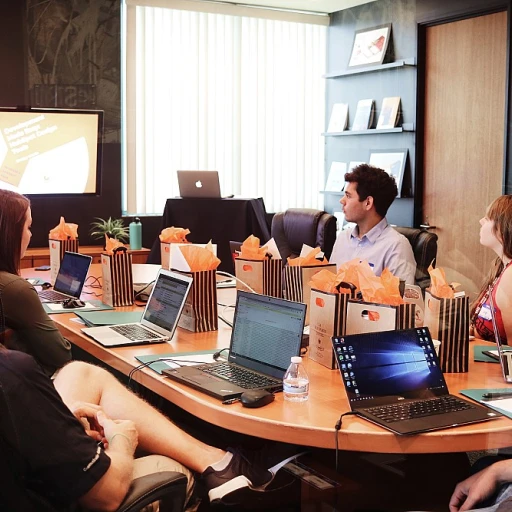Understanding Workforce Planning in Reskilling
Diving into Workforce Planning
Understanding the intricacies of workforce planning in reskilling is crucial for organizations aiming to adapt to ever-changing business landscapes. Workforce planning serves as a strategic tool that employers utilize to align their talent goals with their overall business objectives, ensuring the readiness of their current workforce and paving the way for their future workforce.
In today's environment, companies need more than just a plan; they require a data-driven approach to effectively manage and develop their employees over the long term. Data is pivotal in understanding the collection of skills across an organization, aiding in identifying skill gaps and future workforce needs. Employing a workforce plan rooted in analytics allows organizations to craft a flexible strategy that is responsive to market demands and shifts in business goals.
The role of current workforce analysis cannot be overstated. Through this lens, businesses can conduct a gap analysis, pinpointing areas where skill development is mandatory for future success. This understanding informs the strategic workforce planning process, enabling companies to set a clear direction for talent management and succession planning initiatives.
For a comprehensive view on how these aspects influence leadership and reskilling initiatives, consider exploring an essential resource on
unlocking leadership potential. This exploration emphasizes the importance of incorporating leadership perspectives into workforce planning, ultimately refining the effectiveness of reskilling strategies.
Identifying Skill Gaps and Future Needs
Pinpointing the Critical Areas of Skill Enhancement
Identifying skill gaps within your organization is a fundamental step in workforce planning and reskilling initiatives. It's about understanding the current capabilities of your workforce and aligning them with your strategic business goals. By conducting a thorough gap analysis, companies can pinpoint which skills are lagging and need immediate attention for future business success.
Skill gaps can surface due to various reasons such as technological advancements, market changes, or simply because the organization is setting new strategic priorities. To address these gaps effectively, companies should follow a data-driven approach. Here's how you can begin this process:
- Conduct a Thorough Gap Analysis: Assess the existing skills of your employees and compare them with the skills needed to achieve your organization's future workforce plan. Use this analysis to create a baseline for your talent management.
- Leverage Data Analytics: Utilize workforce data to identify trends and patterns within your organization. This not only highlights the current workforce's strengths and weaknesses but also assists in forecasting long-term needs.
- Engage in Strategic Conversations: Speak with team leaders and department managers to gain insights into the areas needing improvement and explore employees' aspirations and career goals. This collective input can help in prioritizing which skills to reskill or upskill.
- Utilize Succession Planning Templates: To prepare for future talent needs, businesses can benefit from strategic workforce planning templates. These templates aid in visualizing the current versus future positioning of your employees' skills.
The identification process isn't just about spotting deficiencies but also about recognizing potential. Transform these insights into actionable steps, ensuring that every employee’s development aligns with the company's strategic objectives. For more insights into unlocking potential and preparing employees for management roles through structured training programs, consider reading
"Unlocking Potential: The Path to Becoming a Manager Through Training Programs".
Developing a Reskilling Strategy
Building a Comprehensive Reskilling Framework
Developing a reskilling strategy requires a deliberate and structured approach to align the workforce with the company's future needs and goals. Here are some key points to consider when shaping this strategy:
- Define Clear Objectives: First, establish what the organization aims to achieve through reskilling. Consider long-term business goals and how reskilling can support these objectives.
- Conduct a Skill Gap Analysis: Identify the skill gaps within your current workforce through a detailed gap analysis. This step is crucial in determining the specific skills that need development to meet future workforce demands.
- Create a Strategic Workforce Plan: Utilize a data-driven approach to design a strategic workforce plan. This plan should effectively map out the steps needed to bridge current skill gaps and prepare employees for future roles.
- Incorporate Continuous Learning: Develop a culture of ongoing learning and development. By fostering an environment where employees can continuously upskill and adapt, a company can ensure readiness for future challenges.
- Flexible Reskilling Approaches: Implement a variety of reskilling programs to address the diverse needs within the organization. This may include workshops, online courses, mentorship programs, and cross-department training.
- Engage Employees in the Process: Encourage employees to take an active role in their own development. This involves not only providing resources and opportunities but also supporting them through strategic talent management initiatives.
- Regular Evaluation and Adjustment: Monitor the effectiveness of the reskilling strategy and make necessary adjustments based on feedback and performance metrics. Keeping the strategy agile allows organizations to adapt to the ever-changing business landscape effectively.
Developing a robust reskilling framework is not just about preparing for the future. It’s about helping people realize their potential and contributing to organizational success. For further insights, you can explore the
complexities of workforce dynamics in reskilling.
Implementing Workforce Planning Examples
Putting Workforce Planning into Action
Implementing effective workforce planning begins with understanding the skill gaps identified previously and the strategic goals your organization aims to achieve. Here are some actionable steps to consider:
- Customizing a Workforce Plan: Every company requires a unique workforce plan tailored to its specific business goals and future needs. Start by creating a planning template that aligns with your company's strategic objectives. This template will serve as a blueprint for identifying talent needs and potential gaps.
- Conducting a Gap Analysis: Utilize data-driven insights to perform a comprehensive gap analysis. This involves comparing the current workforce skills against the future workforce requirements. By analyzing these insights, you can develop a skill-up strategy that targets specific gaps, ensuring your employees are equipped for long-term success.
- Developing Strategic Initiatives: Once you've identified the key areas needing improvement, develop initiatives such as training programs or workshops. These initiatives should focus on strategic development and aim to upskill your current team, preparing them for future challenges.
- Incorporating Workforce Management Techniques: Effective workforce management goes hand-in-hand with strategic workforce planning. Implement succession planning and talent management strategies that nurture and retain top talent. Adopt a flexible management approach to address unforeseen needs in your workforce plan.
- Utilizing Technology: Leverage technology tools to streamline your planning process. Tools can assist in managing data and tracking progress, ensuring the reskilling strategy stays on course. These tools enable efficient allocation of resources that support the organization’s development needs.
Turning strategic plans into tangible actions involves a clear understanding of how these plans fit within the broader context of organizational goals. This systematic approach ensures that your company's workforce remains adaptable and proactive in a dynamic business environment. By integrating skill development into daily operations, companies can enhance their ability to meet emerging demands, positioning themselves favorably for the future.
Measuring the Impact of Reskilling
Evaluating Reskilling Initiatives
Assessing the impact of reskilling within an organization is critical for several reasons. Businesses need to ensure their workforce planning effectively addresses skill gaps and aligns with strategic objectives. By examining reskilling efforts, companies can determine whether they meet their business goals and adjust their workforce plan accordingly.
- Key Metrics Analysis: Key performance indicators (KPIs) offer a straightforward method of evaluation. Organizations should focus on metrics, such as employee retention rates, productivity improvements, and job satisfaction levels, to measure reskilling success. This data-driven approach helps to align the reskilling strategy with broader business goals.
- Feedback and Surveys: Direct employee feedback provides valuable insights into the effectiveness of reskilling programs. Structured surveys and open forums can help identify whether the new skills acquired are relevant and beneficial for employees’ current roles and future career development. This feedback can guide future reskilling strategies and workforce planning.
- Skill Gap Analysis: Periodic reassessment of skill gaps across the organization is essential. By comparing current workforce capabilities with future workforce needs, companies can determine if their reskilling initiatives are closing identified skills gaps effectively. This continuous gap analysis helps tailor further development programs.
- Business Performance Correlation: A direct correlation between reskilling initiatives and business performance can highlight the value of workforce planning efforts. Improved business metrics, such as increased market share or enhanced client satisfaction, can often trace back to a strategic focus on talent development.
- Long-Term Vision: It's important to view reskilling impact from a long-term perspective. While short-term indicators may suggest quick wins, the ultimate success of a reskilling strategy often unfolds over time, influencing talent management and succession planning processes.
By continuously measuring and optimizing reskilling initiatives, businesses position themselves better to meet future workforce demands, ultimately fostering a more adaptive and skilled organization.
Overcoming Challenges in Workforce Planning
Addressing Common Hurdles in Workforce Planning for Reskilling
As organizations endeavor to implement effective workforce planning in reskilling, they frequently encounter various challenges. Tackling these obstacles is crucial for a seamless transition towards a more agile and skilled workforce.
One predominant issue is resistance to change. Employees often cling to familiar routines and skill sets, fearing the unknown. To ease this transition, fostering a culture that celebrates learning and development can prove beneficial. Encouraging a shift in mindset helps employees see the value in aligning their skills with the company’s long-term business goals.
Additionally, there might be discrepancies between current workforce capabilities and future workforce needs. Deploying a thorough gap analysis aids in identifying these skill gaps and aligning strategies with organizational objectives.
Data-related challenges can also arise. Ensuring access to accurate and comprehensive data is key to planning processes. Organizations need to build robust data systems to track and analyze workforce metrics, facilitating informed decision-making.
Time constraints further complicate reskilling efforts. Many organizations find it challenging to balance short-term productivity with long-term development. Strategic workforce management and meticulous planning templates are essential for defining clear timelines and goals.
Moreover, communication failures often impede successful implementation. Transparent dialogue across all levels of the company ensures everyone is informed and engaged with the reskilling strategy.
Finally, securing management buy-in is crucial. Corporate leadership must endorse the reskilling initiatives, providing the necessary resources and support to sustain momentum.
Overcoming these challenges requires a cohesive approach, prioritizing strategic alignment and comprehensive planning to adequately prepare for the future workforce.













